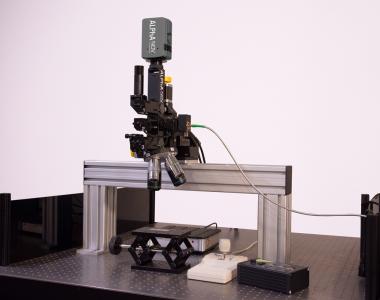Photoemission optical bench
When an integrated circuit is in operation, the zones requested by the routine naturally emit infrared photons through the back side. ALPhANOV’s photoemission optical bench allows to capture and visualize these photonic emissions in order to obtain an accurate view of the circuit activities.
Product reference: Photoemission laser bench
Collect photons naturally emitted by the integrated circuits
This technique involving side-channel analysis of an integrated circuit allows to identify the areas of interest On the circuit. It makes easier laser or EM fault injection, positioning of specific tools or cryptological analysis. There are two observation modes:
- standard IR imaging (image 1 below) which allows to view the circuit through the silicon of the back side
- photoemission imaging (image 2 below) which permits to view the photonic emission of circuit components.
You can then overlay the two images to identify the areas of interest (image 3 below), scan the entire sample and obtain image mosaics.

- Standard infrared imaging through the back side
- Imaging in photoemission mode
- Overlay of the photoemission imaging on the standard view and injection of two spot lasers
A dedicated bench or a multi-function bench

ALPhANOV can provide a dedicated photoemission bench only used for this functionality. It includes a specific optical column, an ultra-sensitive camera, an infrared lighting, high-resolution lenses and XYZ motorized stage which enable to scan the sample accurately.
ALPhANOV can also implement a "photoemission" functionality on a fault injection bench such as the S-LMS (Single Laser Microscope Station) bench, the D-LMS (Double Laser Microscope Station) bench or a Thermal Laser Stimulation bench. Once the photoemission imaging has been analyzed and the area of interest identified, it become easy to perform laser fault injection with the same setup.
Software dedicated to photoemission
ALPhANOV supplies with the photoemission bench a dedicated software enables to:
- obtain a standard IR image across the silicon
- switch automatically to "photoemission" mode to obtain an image of the photonic emissions of the component
- scan the sample and implement a mosaic image
Moving further along, we recommend using the software platform developed by our partner eShard: esDynamic. Compatible with ALPhANOV optical benches, the esDynamic is a powerful platform enables to use notebooks developed in a JupyterLab environment, to implement your own developments, and to summarize and analyze your results. The esDynamic platform is also used for side-channel analysis.

Product features
- Spectral band: 900-1700 nm
- Resolution: 640*512 px or 320*256 px
- Cooling system by TEC
- Compatible with the eShard platform esDynamic


Associated products or services
-

Single laser fault injection microscope - S-LMS
The S-LMS microscope station for laser fault injection is a high-precision platform for security evaluation of integrated circuits. It allows you to focus the laser spot and scan the sample through the back side in order to evaluate the security levels of the electronic components. -

Double laser fault injection microscope - D-LMS
The D-LMS microscope station for double laser fault injection is a platform allowing to focus and scan independently two laser spots for security evaluation of integrated circuits. Ideal for double spot injection processes, it offers all the spatial and temporal flexibility to analyze circuits through the back side. -

PDM laser sources - Pulse-on-demand Modules
PDM laser sources are specially designed for security evaluation of integrated circuits. Reliable and robust, these laser sources allow you to generate pulses on demand of less than 1 nanosecond, up to continuous with a timing precision of 8 ps and a spot size of 1 µm. -

Thermal Laser Stimulation - TLS
The thermal laser stimulation bench is an optical microscope which enables to focus with precision, a PDM+ laser source (Pulse-on-Demand Module) at 1420 nm. Used through the back side of electronic components, the laser beam warms the sample locally and allows to extract and read out data in a memory according to the current consumption of the transistors. -

Tombak: Pulse Delay Generator
This pulse delay generator generates high frequency pulses, digital delays and bursts. It is an ideal synchronization and timing control instrument for electronics and lasers.